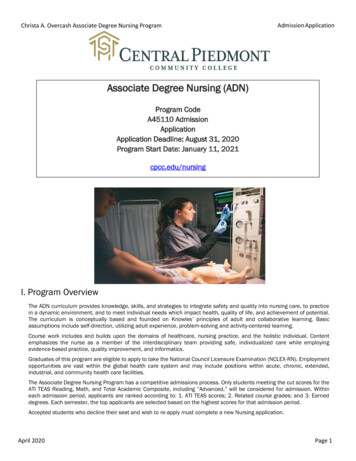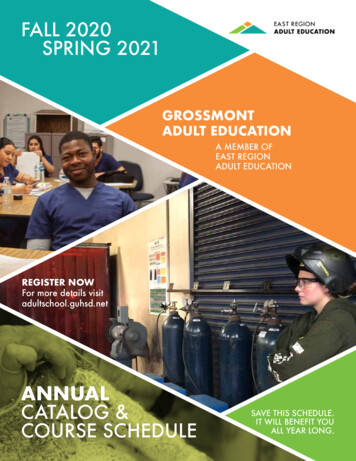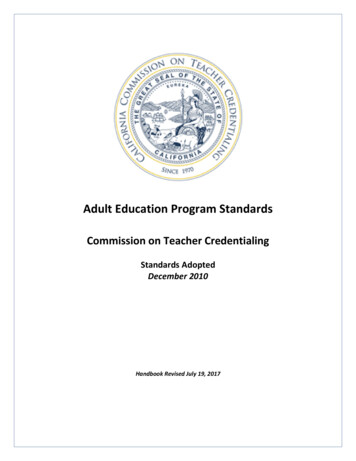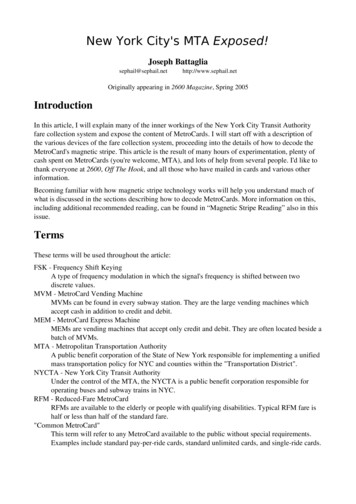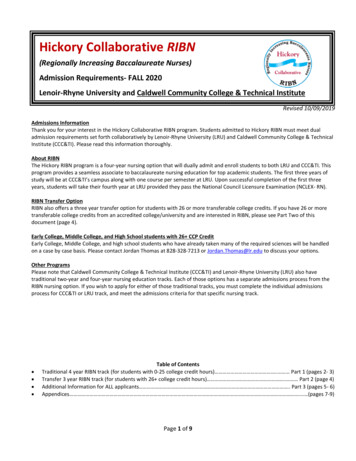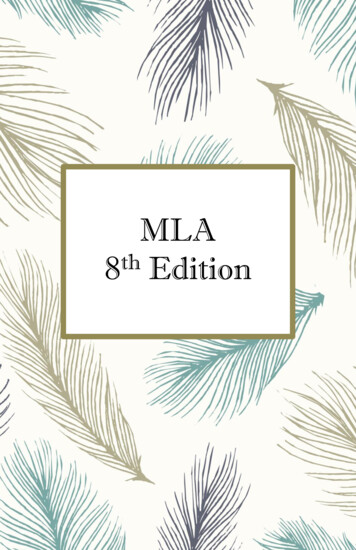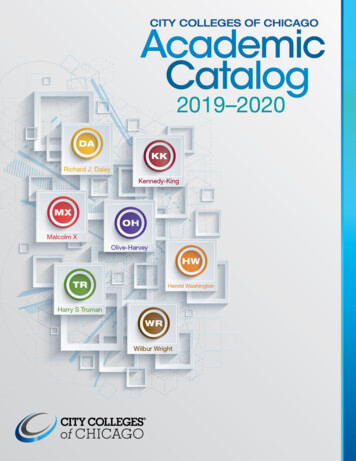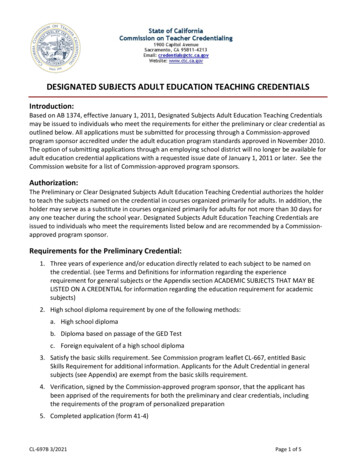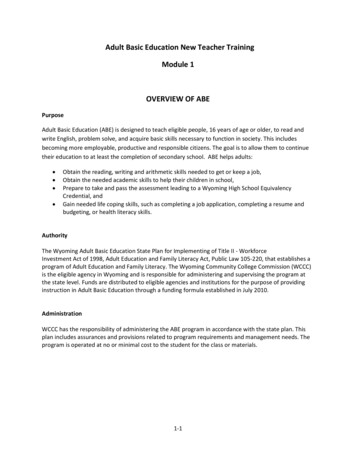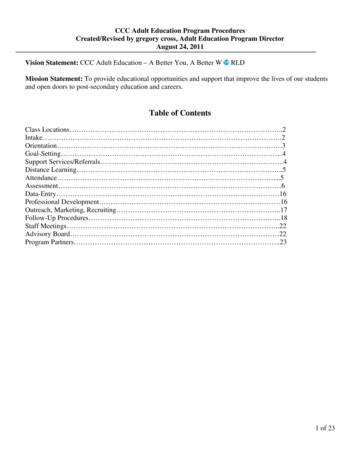
Transcription
CCC Adult Education Program ProceduresCreated/Revised by gregory cross, Adult Education Program DirectorAugust 24, 2011Vision Statement: CCC Adult Education – A Better You, A Better WRLDMission Statement: To provide educational opportunities and support that improve the lives of our studentsand open doors to post-secondary education and careers.Table of ContentsClass Locations .2Intake .2Orientation .3Goal-Setting .4Support Services/Referrals .4Distance Learning .5Attendance .5Assessment 6Data-Entry 16Professional Development 16Outreach, Marketing, Recruiting .17Follow-Up Procedures .18Staff Meetings .22Advisory Board 22Program Partners .231 of 23
Class LocationsAdult Education classes including ABE/ASE/ELAA are held at three locations in the County. CCC Fourth Street, Room B-33CCC Page Adult Ed ClassroomCCC Williams, Rooms 101 and tional evening orientation sessions are held at the Lone Tree campus. Distance learning classes areoffered throughout the County through the distance learning grant from the State.IntakeIntake is conducted at each site and includes the following steps:At first contact, students complete three required forms. These include the ADE Adult Education StudentRegistration Form, the AZ Adult Education Verification of Eligibility for Services Form (ARS 15-232) andthe CCC Adult Education Registration Form (fees). (see appendices)Student Registration Form – students complete both sides of this form and return to instructors whocheck that all fields have been filled in and that the form has been signed by the student.Eligibility for Services Form – students complete the upper portion of the form and submit requireddocuments to the instructor. Instructors photocopy the documents, complete the lower portion of theform and sign, then attach the document photocopy to the form. Students who are unable to producedocumentation are so noted in ARS 15-232 logs and denied service. Completed registration formsplaced in “denied service” folder serve as ARS 15-232 log.Registration Form (fees) – Students complete all fields in the upper half of the form including incomeand family size. Guidelines for determination are included on the back of the form. Students read thewarning statement and sign and date the form. Instructors make the fee determination based on asliding scale, indicate the fee amount in the Y (year) or H (half-year) column and sign and date theform. The half-year designation begins on January 1st of each program year.Note: beginning July 1st, 2010, there will be no fee for English language classes and distance learningstudents will pay a fee.All completed forms are entered into student folders.In Page and Williams, students are directed to a cashier and may begin classes as soon as a fee receipt isreturned to the instructor. At Flagstaff sites, orientation requirement is explained and session dates areprovided. Students sign up for their preferred dates. After attending orientation, students pay the predetermined fee at a CCC cashier’s desk (Lone Tree or Fourth Street only) and return the receipt for admissionto class. Instructor verifies that the amount paid is equal to the fee initially determined and attaches the receiptor a photocopy thereof to the fee form. A “paid” stamp including cashier’s signature and date serves as areceipt.Fees are based the sliding scale below which considers family size and annual income. These two pieces ofinformation are self-reported by students and do not require documentation.2 of 23
201up to 10,8302up to 14,5703up to 18,310Family4up to 22,050Size5up to 25,7906up to 29,5307up to 33,2708up to 37,010 30 14,404 19,378 24,352 29,327 34,301 39,275 44,249 49,223 40 18,086 24,332 30,578 36,824 43,069 49,315 55,561 61,807 50 21,660 21,661or more 29,140 29,141or more 36,620 36,621or more 44,100 44,101or more 51,580 51,581or more 59,060 59,061or more 66,540 66,541or more 74,020 74,021or moreFees 60OrientationOrientations are usually scheduled twice each month except for December and June when no sessions arescheduled. There is no orientation in June because the program year ends on June 30, and it is difficult for astudent to make an educational gain in that time. There is no orientation in December because the program isonly open for a few weeks before the winter break. Sessions are 9 hours long. Weekday orientations are heldat the Fourth Street Campus on Tuesday, Wednesday and Thursday from 9am to noon. Evening orientationsare held on three weeknights from 5:30 to 8:30pm. Currently, Page and Williams conduct orientation on anindividual basis.Potential students must register in person for orientation. They will fill out the state intake form, ARS 15-232paperwork and the fee intake form. Instructors determine appropriate fees based on the students’ income andfamily size as indicated on the sliding scale. They are then scheduled for a specific orientation date; the signup sheets are available at each center. They take home the reminder sheet with their orientation date, time andlocation. They are directed to call if they need to cancel or reschedule, even if they call just before orientationbegins.Registered ABE/ASE students proceed to their assigned orientation and complete nine hours of activities, asprovided by specially trained staff on a semi-monthly basis. Orientation content includes: Introduction to the processes and concepts of adult edAttendance and separation policiesTransition and support services available to studentsFinancial benefits of GED and higher educationTABE placement testingLearning styles and career inventoriesWriting sampleGoal explorationStudents who complete the nine hours of orientation are now registered.3 of 23
Goal-Setting1. Goal exploration – Takes place during orientation (should be completed during TABE test scoring atsites with individual orientation). Page one “Goal Exploration Worksheet” is the checklist to be usedfor this. Students should be reminded not to fill out the back of the page “Goal Setting Worksheet”.Worksheets are placed in student folders. (see appendices)2. Counseled goal-setting – Takes place during students’ first visit to the classroom following orientation,after reviewing test results with students (should occur during a student’s return visit at sites withindividual orientation). Page two “Goal Setting Worksheet” is to be used for this. Teachers should helpstudents individually to set short-term, achievable goals, both educational and personal. Worksheetsremain in student folders.3. Assessment and goals records completed – Assessment and goal information including dates is enteredon these state developed forms and verified with teacher signature and date. Time allowing, this shouldbe done immediately following goal-setting. This will prevent accumulation of work to be done at theend of each month prior to data entry. Assessment and goals records remain in student folders.4. Data entry – On the final class day of each month, all information on the assessment and goals recordsfor each student should be entered into the database (NRSpro) at each site. At sites with highenrollment, this could take up to one hour so teachers need to plan their time accordingly. Data entryfor Flagstaff and Williams is completed by the program assistant. Data entry in Page is completed bythe classroom instructor. Each person with data entry responsibility will receive complete training onthe NRSpro database.5. Revisiting goals and setting new ones – This takes place immediately following progress testing. See“Progress Assessment Exception Form” (in appendices) if student is post-tested before completing 60hours or 60 calendar days. For more detail, see state assessment policy on page 6 (yellow highlights).Teachers meet individually with students to discuss progress towards goals previously set on “GoalPlanning Worksheet”. For each goal achieved, a new goal should be set, including educational andpersonal ones. This will require a new copy of the “Goal Planning Worksheet”.6. Student Satisfaction Survey – After revisiting goals and setting new ones, students should be directed tothe student satisfaction survey found on the adult webpage under “Resource Links for Current Students”on the left sidebar. They should not use the orientation survey.7. Assessment and goals records completed – This is essentially the same as step three but progress testscores and goal achievement should be recorded, dated and verified. New goals set should be indicatedon the upper portion of the “Assessment and Goals Record”. (see appendix)8. Data entry – Again, this is essentially the same as step four. The goal is to have all info on the“Assessment and Goals Record” forms entered into NRSpro with 100% accuracy at the end of eachmonth.Support Services/ReferralsDuring the process of goal-setting, students may convey support needs that are not or cannot be provided bythe adult ed program. In these cases, referrals should be made to appropriate agencies. A complete listing ofCoconino County social services is available at: 4 of 23
Distance LearningCCC Adult Education partners with the Phoenix Indian Center to provide distance learning for students livingin rural areas or with other obstacles to attending center-bases classes. CCC expects to serve 25 studentsthrough its DL budget ( 12,500 at 500 per student). Five seats will be reserved for PIC students with moreoffered as available.All distance learning candidates must complete initial assessments at a CCC learning center or at the PhoenixIndian Center. Students in the Tuba City area who qualify for the Navajo Nation Self-Reliance program maycomplete assessments at the Tuba City office.Criteria for student DL eligibility: TABE reading level of ABE II or higherTechnology skills, especially e-mail and website navigationAppropriate profile as identified by Project IDEAL learner intake surveyIntroduction to time management skills (using calendars, meeting deadlines)Access to computer with Internet connectionIt is suggested that all DL appropriate students be offered a tryout period ( one month). During this period,students will be assigned some pre-tests and an essay topic, will communicate with the DL teacher and returnto the learning center site to debrief. Final determination of eligibility will be determined at this visit andrecommendations made.CCC’s DL instructor will monitor progress and make regular contact with students. When the instructordetermines that a student has made sufficient progress, the student will be directed to return to a learningcenter for follow-up assessment.AttendanceStudent HoursStudent class attendance is recorded daily on attendance sheets (see attached) with student name, signature,time in, time out and subject area (ABE/ASE or ELAA). Attendance records are compiled monthly andentered into spreadsheets by instructors at each center. Spreadsheets are sent electronically to data entryperson who enters attendance hours into class records for each student.At least once a day, staff should calculate total hours on the attendance sheet. Time is calculated to the nearestquarter hour in minute form. Example: one hour and 15 min. is written as 1:15 hrs. The instructor whocalculates attendance hours on sheets should sign at the bottom of the page.These spreadsheets are to be sent electronically to the program’s data entry person no later than the end of thefirst week of each month.The program’s data entry person will enter each student’s hours from site spreadsheets into NRSpro on amonthly basis.5 of 23
Arizona Adult EducationAssessment Requirements PY 2009-2010State Context for AssessmentOverviewThe assessment requirements in this document provide a detailed explanation of the state and local programresponsibilities for student assessment specific to the National Reporting System (NRS) and state requirements. Theserequirements apply to the approved assessments and test administration procedures that programs must use to reporteducational gains in compliance with NRS requirements.Programs must adhere to the assessment requirements identified in order to provide fair and equitable access toservices for learners, make decisions about the program, identify the need for program improvement, and makeconsistent judgments about learner placement and advancement.The assessment requirements are based on Arizona Adult Education historical data and the approved assessments’publisher’s guidelines, CTB McGraw/Hill.NRS requirements and accountabilityThe use of reliable and valid learner assessments is basic to any functioning assessment requirement. An assessmentis considered valid if it has been determined to accurately measure the skills and abilities that it claims to measure. Anassessment is considered reliable if it can consistently measure the skills and abilities of all learners for which theassessment was designed.Arizona’s Adult Education requires the uniform implementation and administration of valid and reliable assessmentinstruments that align to the NRS levels in order to document student achievement. Uniform implementation ofassessment procedures benefits the learner, the program and the State by ensuring and enabling: Accurate and standardized learner placement into appropriate instructional levels. Genuine comparison of program, teacher, and learner success. Identification of program service areas that are in need of improvement. Creation of a basis for selecting state sponsored Professional Development activities. Creation of a basis for informing instruction that aligns with state standards.By requiring the uniform implementation and administration of valid and reliable assessments, the state of Arizona willgenerate data that allows both reporting on program performance accurately and targeting instruction to demonstratedspecific needs of adult learners.Purpose and uses of assessmentPrograms should understand that use of the standardized assessments for reporting purposes differs from instructionalfunctions when using the results of standardized assessments. Reporting functions of assessment include: Setting uniform program performance standards, Establishing a uniform basis for performance based funding awards, Measuring uniform gains in learner knowledge, and Comparing the success of programs in meeting performance standards.Instructional functions of assessment include: Determining the effectiveness of instruction, Determining the specific needs of adult learners, and Identifying statewide professional development needs.ADE/AES encourages programs and individual instructors to use supplemental assessments to aid in identifying learnerneeds and guiding instruction. These alternate assessments, however, no matter how useful as a supplement for6 of 23
informing instruction, may not substitute for the standardized instruments prescribed for NRS reporting and educationalgain measurement.SummarySo that ADE/AES operations can be aligned with assessment objectives, all adult education programs funded by thestate of Arizona must use the Test of Adult Basic Education (TABE) for ABE and ASE levels and the TABE CLAS E testfor ELAA learners. Local programs’ assessment procedures must follow the publisher’s guidelines and the establishedstate requirement. Programs must pre-test all learners within the first 12 hours of instruction and must follow up with apost-test during the period allowed under state requirement as described in this document. Uniform implementation ofthe assessment procedures outlined here is necessary for the successful comparison of program efforts and will bemonitored by ADE/AES. Deviance from the requirements and procedures outlined here will be seen as a complianceissue.Direct questions on assessment requirements and procedure or requests for technical assistance to:Arizona Department of Education, Adult Education ServicesMiriam Kroeger miriam.kroeger@azed.gov orPaul Franckowiak paul.franckowiak@azed.gov orGinny Seltenright virginia.seltenright@azed.gov1535 W. Jefferson, Bin #26Phoenix, AZ. 85007Phone: 602.258.2410Fax: 602.258.4986Website: http://www.ade.az.gov/adult-ed/General Assessment RequirementsTraining Program personnel can administer the assessment only after receiving training from ADE/AES personnel or an ADEsponsored training from CTB McGraw/Hill personnel and reading the appropriate manual (TABE forms 9/10: Survey,Test Directions or TABE CLAS E Test Manual Test Directions).oA minimum of at least 1 person must be trained to administer assessments from each program.oThe additional number of trained administrators is at the program’s discretion.oNew staff must be trained within 2 months of hire date.oPreviously trained staff must take a refresher course annually. ADE/AES will maintain a list of authorized test administrators and the programs for which they work. It is alsoexpected that programs will maintain their own lists of trained personnel. Program Directors will submit a list of personnel administering assessments to learners to ADE/AES as part of theirannual report. ADE/AES will provide two group assessment trainings during each program year. ADE/AES staff will provideadditional assessment trainings as necessary. Training will be provided to staff that either administer or score each of the tests used to measure educational gains. Additional training will be provided for teachers and other local staff involved in gathering, analyzing, compiling andreporting data. Training procedures and materials developed by ADE/AES will be used to train staff onoNRS requirements, accountability requirements, and the data collection process,odefinitions of measures, andostandardized processes for conducting assessments.7 of 23
TimelinesTesting timelines reflect recommendations issued by test publisher CTB McGraw Hill, the Office of Vocational and AdultEducation (OVAE), and the NRS: Initial assessment must be completed during the first 12 hours after registration; Progress testing must not occur before 60 attendance hours for students initially placed into ESL Beginning Literacy,ESL Beginning Low, ESL Beginning High, ESL Intermediate Low, ABE Beginning Literacy, ABE Beginning Basic,and ABE Intermediate Low. Classes at these levels must be scheduled for at least 60 hours.oExceptions to progress testing guidelines for these levels should be limited and rare. All exceptions aredocumented on a “Progress Assessment Exception Form” (developed by Arizona Department ofEducation/Adult Education Services (ADE/AES) and available at http://www.ade.az.gov/adult-ed) andare signed by the learner and by the Program, Learning Center Director, or Instructional Supervisor, andare available for review by ADE/AES. Progress testing may occur before 60 hours for students initially placed into ESL Intermediate High, ESL Advanced,ABE Intermediate High, ASE Low and ASE High if they have a goal of entered employment, retained employment,obtained a GED or secondary school diploma or entered postsecondary education or training in addition toeducational gains. No Exception Form is necessary for these students. If a learner stops out and then returns to the program for 90 days, it is necessary to administer a new assessment. Learners with continuous attendance that crosses a fiscal year can be counted in both years. The initial test, alongwith attendance hours through June 30, would be counted in the first fiscal year. The progress test a
Distance learning classes are offered throughout the County through the distance learning grant from the State. Intake . Intake is conducted at each site and includes the following steps: At first contact, students complete three requ
